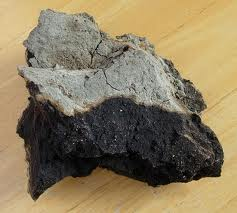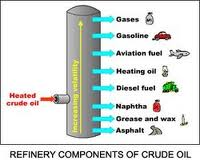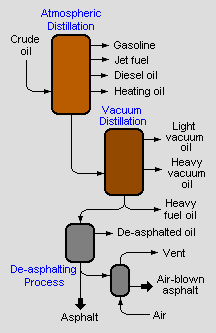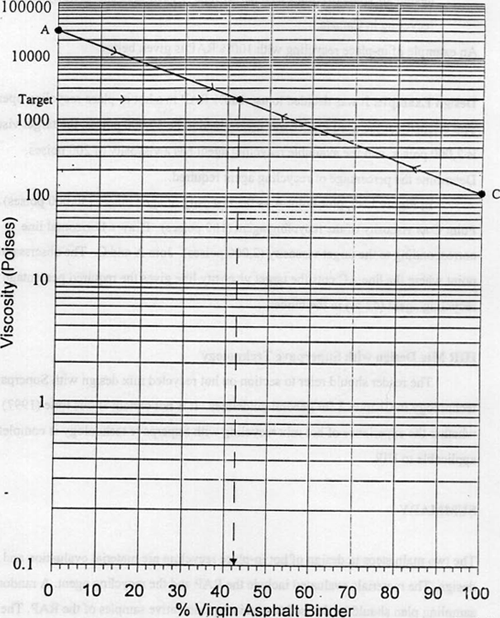Introduction
The composition of crude oil is infinitely varied and complex. This is because of the several components that can be derived from crude oil after the separation process of distillation. However, the components derived from crude oil vary with the original location of the crude oil (Barth, 1962, p. 56).
For instance, crude oil found in West Virginia and Pennsylvania has a lot of wax, which may not be found in crude oils found in other regions. On the other hand, crude oil found in California is known to exhibit a lot of asphalt. Among the various components that can be separated from crude oil include lubricating oil, wax, heavy fuel oil, naphtha, tar, and asphalt just to mention a few.
In this section, the production, history, and uses of asphalt will be discussed. “Asphalt is a semi-solid or highly viscous substance that could be found as natural deposits or could be manufactured from crude oil. Asphalt is black in colour and very sticky given its high viscosity” (Freemantle, 2013, p.1).
It is important to note that asphalt is something that we see and step on almost every day. Indeed, asphalt is the core substance in the construction of roads and airplane runways. It is because of the presence of asphalt that roads and runways are black. With this in mind, it can be deduced that asphalt is heavily used globally. For instance, the United States of America alone uses about 70 billion lb of asphalt yearly. However, this usage is expected to increase in future given the high rate of development.
A big percentage of the asphalt used today is derived from the distillation process of crude oil. In fact, asphalt happens to be the residual product of crude oil distillation. “As such, asphalt comprises of saturated and unsaturated compounds as well as aromatic compounds whose composition differs with the source of crude oil” (Barth, 1962, p.56).
However, most aliphatic compounds contain sulphur, nitrogen, heteroatoms, and oxygen among other compounds. “Typical asphalt will be made up of 80% carbon, 10% hydrogen, 6% sulphur, and small quantities of nitrogen and oxygen” (Freemantle, 2013, p.1).Trace elements such as iron, vanadium, and nickel will also be found in asphalt. Most of the aliphatic components have a high polarity, thus easily dissolving in polar substances such as hexane and heptanes.
Aliphatic compounds exhibit high polarity due to the presence of functional groups such as amine, alcohol, and carboxyl in their structure. Nevertheless, asphalt is said to be thermoplastic in nature given its polymer network. Above all, asphalt is hard and able to withstand harsh temperature changes and forces hence its use in road construction. Below is an image showing an asphalt particle.

Fig. 1 (Barth, 1962, p.67)
History of Asphalt
Asphalt has been in existence for the longest time in history since 4000 B.C. Asphalt was first realized as deposits that occurred naturally on earth. It was thought that these deposits were as a result of ancient remains of living things such as microscopic algae and other diatoms.
These remains were found at sea beds, lake bottoms, and mud, which were inhabitants of living things. Having been found in the ancient times, asphalt had several uses including being used in binding of bricks, cementing carvings, waterproofing, and ship caulking among other uses.
“The bible indicates that the Tower of Babel was constructed using asphalt as a binding substance for the bricks” (McNichol, 2005, p.104). This therefore shows that asphalt is as old as the bible. The Dead Sea commonly known as the Palus Asphaltites (Asphalt Lake) by the Romans was the major source of asphalt for the Egyptians.
Asphalt air blowing unit
Upon distillation, crude oil is bound to recover various products including gases, heavy fuels, naphtha, wax, and asphalt. As mentioned earlier in the paper, asphalt is the residue of crude oil distillation thus being the lowest substance in the distillation unit as depicted in the figure below.

Fig. 2 (McNichol, 2005, p. 107)
Crude oil distillation involves two stages of atmospheric and vacuum distillations. Atmospheric distillation entails heating the oil at temperatures above atmospheric pressure thus recovering gases and light density substances such as gasoline, jet fuel, and heating oil. Vacuum distillation is conducted at pressures that are absolute as well as under vacuum conditions of 10-40 mmHg. This stage is meant to recover heavy fuel oil as shown in the diagram below.

Fig. 3 (Volodin et al., 2003, p. 213)
As depicted in the above diagram, once the distillation process is over, oil with asphalt is extracted and de-asphalted before it goes through the air blowing process. The air blowing process of asphalt entails the use of an air compressor that is sued to blow air through the liquid asphalt that remains after distillation.
This process takes place at temperature ranges of 235 to 290 0C (Volodin et al., 2003, p. 213). Asphalt is heated until it attains this temperature range and then held in the blowing tower. Hot air is injected in the blowing tower for a predestined period. The high heated air is introduced into the blowing column through the bottom part of the column.
This air is normally meant to agitate mixing of the heated asphalt in a bid to increase the surface area for intended reaction. The air blowing process is carefully conducted to avoid any instances of asphalt combustion. As such, the temperatures are normally below the asphalt flash point just to avoid the possibility of combustion.
The air blowing process involves exothermic reactions since heat is produced. It is important to note that oxygen in the air used in the process causes the asphalt to oxidize. On the other hand, the asphalt is dehydrogenized thus making it increase in molecular size. Several factors affect the reaction rate in the blowing column. These include the temperature used, residence time, the air-to feed ratio, as well as the viscosity and origin of the asphalt fed.
Asphalt emulsifying process
After the air blowing process, the extracted asphalt undergoes an emulsification process to come up with an asphalt emulsion. The emulsifying process essentially entails mixing of the asphalt with water at reduced melting point temperatures. An emulsion can be simply defined as the dispersion of one liquid’s droplets in another liquid of different densities. Most often than not, emulsions are either oil in water or water in oil mixtures.
Common examples of emulsions include butter, creams, and mayonnaise among others. “An emulsion of asphalt ideally contains 70% asphalt with the rest being water and chemical additives” (Freemantle, 2013, p.1). This is because the emulsion is prepared by mixing asphalt with water in addition to emulsifying agents. The emulsifying agent function is to disperse the asphalt globules thus making them far from each other.
This helps in space creation in between the globules for water globules to bind hence forming an emulsion. Through the application of mechanical energy adequate to break down the asphalt into small particles, the emulsion process sets on. The aim of the mechanical energy is to lower the viscosity of asphalt and make it miscible with water and other substances. The reason behind the emulsification of asphalt is to make it workable at different temperatures given the fact that asphalt is normally very hard at low temperatures.
Before emulsification, asphalt is of brown colour, which significantly changes to black upon emulsification. This turning of colour is an indication that the emulsion is broken after the evaporation of the water. It should be noted that the time taken for the water used in emulsification to evaporate and set is dependent on the emulsion type.
Below is a typical diagram showing the emulsification process of asphalt.

Fig. 4 (Volodin et al., 2003, p. 213)
The blending process
“Upon emulsification, asphalt becomes miscible with each other as well as with other liquids in different proportions” (Freemantle, 2013, p.1). This then makes it possible to produce different blends of asphalt that are of different characteristics. The blending process of asphalt is determined by the softening and penetration points of the asphalt hence the need for blending charts.
The charts show the softening and penetration points of the asphalts intended to be blended. The meeting point of the two line graphs on the chart is then used during blending. The softening points are determined by measuring the viscosity of asphalt using a viscoliner and a graph similar to the one below derived.

Fig. 5 Use of asphalt viscosity blending chart (Volodin et al., 2003, p. 215)
Examples of asphalt blends
Asphalt/wax blends
In this type of blend, paraffin wax is blended with asphalt. The fact that paraffin wax has a low melting point of about 600C when blended with asphalt, the outcome product has a lower viscosity than the original asphalt. This blend also has a reduced tackiness especially during low temperatures.
Asphalt/ Petroleum oil blends
These are commonly referred to as cutbacks. These blends are made from petroleum oil products such as gas oil, kerosene, and naphtha among others. When blended, the product is normally softer than the original asphalt.
Types and grades of asphalt produced
There are different types and grades of asphalt produced during processing. These types differ in terms of composition, physical characteristics, and appearance. Some of the common types and grades of asphalt include the following:
- Mastic asphalt: This is commonly known as sheet asphalt. It has a low percentage of asphalt. “It is mostly used in road construction as well as footpath construction. Some of it is used in flooring and roofing” (Freemantle, 2013, p.1). This is mainly because of its slippery characteristic, which makes it hard to absorb water.
- Cut-back asphalt: This type is made by blending asphalt with kerosene and then mixing it with aggregate. This makes it environmental unfriendly since it causes pollution. As such, it has been rendered illegal in most parts of the world. As time goes by, the asphalt becomes hard due to the loss of kerosene through evaporation.
- Hot Mix Asphalt (HMAC): As the name suggest, this type of asphalt is produced at high temperatures of about 1600C. This means that this asphalt is of low viscosity and with less moisture thus very durable. As such, this type of asphalt is preferred for use in highways, airport runways and other areas of high traffic (Volodin et al., 2003, p.214).
- Warm mix asphalt: The temperatures in this type of asphalt are relatively low, thus allowing the addition of wax and other substances to form emulsions. The process of making this asphalt is deemed environmental friendly because of reduced emission and low consumption of fuel. The only problem is that the warm mix asphalt is not as durable as hot mix asphalt. As such, it is used in areas of low traffic or used to patch damaged hot mix asphalt concrete.
Specification and properties of each type of asphalt produced (high penetration, low penetration, etc)
Grading of asphalt according to its penetration abilities is a system that began as early as in the 1900s. Penetration of asphalt is determined using a needle of 100 grams, which is inserted in the asphalt at a temperature of 250C. Using this test, the standard needle will penetrate deeper in less viscous asphalt, which is then graded as high penetration asphalt.
In low penetration asphalt, the needle will not penetrate or have a shallow penetration. Penetration grading is important in determining the type of asphalt to be used in different climatic regions. In that case, the low penetration asphalt is used in regions of high temperature while the high penetration asphalt used in cold climatic regions. Nevertheless, this method has attracted much controversy with the critics arguing that the method is not ideal, as it does not test fundamental parameters such as viscosity.
Uses and application of different types of asphalt
Asphalt is mostly used in making asphaltic concrete that is a material for road construction. “The consumption of petroleum asphalt on asphaltic concrete is approximated at 80% of all petroleum asphalt used in the U.S. It is normally used as glue holding together crushed stones, sand, slag, gravel, and other materials” (McNichol, 2005, p. 67).
For instance, rolled asphaltic concrete has the asphaltic binder and aggregate, cutback asphalt has petroleum solvents, asphalt emulsions contain chemical additives and asphalt, and mastic has less aggregate than rolled asphaltic concrete.
Secondly, asphalt is used in roofing shingles, which account for about a fifth of all asphalt used in the U.S. Roofing materials made of asphalt are actually the dominant roofing material in the U.S (McNichol, 2005, p. 34). In China and Japan, asphalt is incorporated in ceramics thus making them waterproof. In France, asphalt is embedded in photography and art where it used to make photographic films that are fitted in cameras.
Asphalt is also used in paving of parking lots for vehicles and runways in airports. In addition to this, it is also used in making dam facings, canals, and reservoir linings. Asphalt has also been used in making battery casings and floor tiles. Due to its waterproofing property, asphalt is used to waterproof materials like fabrics.
It can also be used in making cattle sprays and treating wooden objects and materials like wooden fence posts. Overall, the usefulness of asphalt comes as a result of its binding property and its waterproofing property. These properties work together to ensure that materials with asphalt are tough, hard, and durable.
Conclusion
From the above discussion on asphalt, it can be deduced that asphalt is indeed an important component despite being the residue product in crude oil distillation. Asphalt is the product that remains after distillation of crude oil although it could also be found as natural deposits in sea and lakebeds.
In order to be rendered appropriate for use, asphalt undergoes various processes such as air blowing, emulsification and blending among others (Barth, 1962, p. 68). Additionally, asphalts are of different types with the main differences being physical properties and applications. Common types include mastic, hot mix, warm mix, and cut back asphalts.
Asphalt is the core product in the construction of roads and airport runways (Volodin et al., 2003, p. 214). Other uses of asphalt mentioned in the paper include roofing, flooring, waterproofing and binding just to mention a few.
Despite having several uses, asphalt has proven to have significant health impacts especially after prolonged contact with the substance. Asphalt fumes whose common way of exposure is through inhalation, pose health dangers to the respiratory system of a human being.
Some of the immediate respiratory problems felt after exposure include cough and through irritation. If not immediately treated, lung cancer could arise. Asphalt fumes have also been depicted to bring about skin rashes, irritation of eye, headache, and fatigue among other minor ailments. Being carcinogenic, asphalt fumes could lead to different types of cancers such as stomach and throat cancer in cases of prolonged exposure.
Reference List
Barth, E. (1962). Asphalt: Science and Technology. New York: Gordon and Breach.
Freemantle, M. (2013). Asphalt. Retrieved from http://pubsapp.acs.org/cen/whatstuff/stuff/7747scit6.html?
McNichol, D. (2005). Paving the Way: Asphalt in America. Lanham, MD: National Asphalt Pavement Association.
Volodin, Yu, et al. (2003). Production of Asphalt from Activated Crude Oil Residues. Chemistry and Technology of Fuels and Oils, 39(4), 213-215.